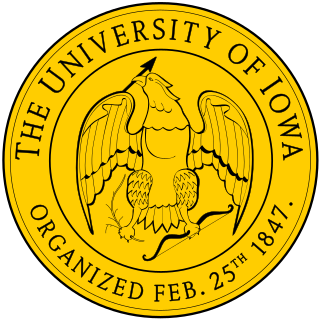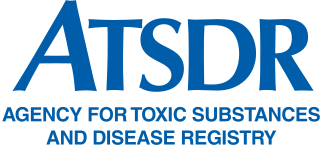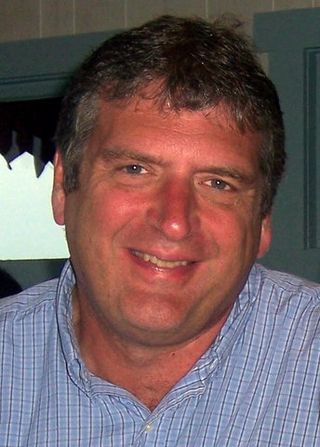Related Research Articles

Polychlorinated biphenyls (PCBs) are organochlorine compounds with the formula C12H10−xClx; they were once widely used in the manufacture of carbonless copy paper, as heat transfer fluids, and as dielectric and coolant fluids for electrical equipment. They are highly toxic and carcinogenic chemical compounds, formerly used in industrial and consumer electronic products, whose production was banned internationally by the Stockholm Convention on Persistent Organic Pollutants in 2001.

The University of Iowa is a public research university in Iowa City, Iowa, United States. Founded in 1847, it is the oldest and largest university in the state. The University of Iowa is organized into 12 colleges offering more than 200 areas of study and 7 professional degrees.

The Agency for Toxic Substances and Disease Registry (ATSDR) is a federal public health agency within the United States Department of Health and Human Services' Centers for Disease Control and Prevention. The agency focuses on minimizing human health risks associated with exposure to hazardous substances. It works closely with other federal, state, and local agencies; tribal governments; local communities; and healthcare providers. Its mission is to "Serve the public through responsive public health actions to promote healthy and safe environments and prevent harmful exposures." ATSDR was created as an advisory, nonregulatory agency by the Superfund legislation and was formally organized in 1985.

David Platt Rall was a cancer specialist and a leader in environmental health studies, whose work in environmental health helped turn it into a scientific discipline. Rall also advanced public health and prevention. He directed the National Institute of Environmental Health Sciences from 1971 to 1990, year in which he retired. His work on toxicology and carcinogenesis was recognized by his appointment as the first director of the National Toxicology Program in 1978. He held the rank of Assistant Surgeon General in the United States Public Health Service. He also chaired the World Health Organization's Program on Chemical Safety.

R. William Field is an academic scholar and Professor in the Department of Occupational and Environmental Health and Department of Epidemiology within the College of Public Health at the University of Iowa. He received a BS and MS degree in Biology from Millersville University of Pennsylvania and a PhD in Preventive Medicine from the College of Medicine at the University of Iowa in 1994. Field is currently an occupational and environmental epidemiologist as well as an internationally recognized expert on the measurement and health effects of radon gas.
Skin absorption is a route by which substances can enter the body through the skin. Along with inhalation, ingestion and injection, dermal absorption is a route of exposure for toxic substances and route of administration for medication. Absorption of substances through the skin depends on a number of factors, the most important of which are concentration, duration of contact, solubility of medication, and physical condition of the skin and part of the body exposed.
The Superfund Research Program (SRP) was created within the National Institute of Environmental Health Sciences in 1986 under the Superfund Amendments and Reauthorization Act (SARA). The SRP is a university-based research program that supports the national Superfund program by addressing a wide variety of scientific concerns.
College of Pharmacy is part of the University of Arizona, a public university in Tucson, Arizona, United States. It is the only pharmacy school at a public Arizona university and one of four health professions colleges at the Arizona Health Sciences Center campus. The college is accredited by the Accreditation Council for Pharmacy Education.

Environmental toxicology is a multidisciplinary field of science concerned with the study of the harmful effects of various chemical, biological and physical agents on living organisms. Ecotoxicology is a subdiscipline of environmental toxicology concerned with studying the harmful effects of toxicants at the population and ecosystem levels.
In analytical chemistry, biomonitoring is the measurement of the body burden of toxic chemical compounds, elements, or their metabolites, in biological substances. Often, these measurements are done in blood and urine. Biomonitoring is performed in both environmental health, and in occupational safety and health as a means of exposure assessment and workplace health surveillance.

Robyn Leigh Tanguay is an American researcher, academic and educator. She is a distinguished professor in the department of environmental and molecular toxicology at Oregon State University. She is the director of Superfund Research Program, the director of Pacific Northwest Center for Translational Environmental Health Research and the director of Sinnhuber Aquatic Research Laboratory at OSU.

Linda Silber Birnbaum is an American toxicologist, microbiologist and the former director of the National Institute for Environmental Health Sciences, as well as the National Toxicology Program, positions she held from January 18, 2009 until October 3, 2019. She also serves as an adjunct professor at the University of North Carolina at Chapel Hill School of Public Health and as a member of the editorial board of Environment International.
Sibte Hasan Zaidi was an Indian pathologist and toxicologist. He underwent training in pathology at the Hammersmith Hospital in London, United Kingdom and later returned to India to continue with experimental toxicology research.
Oregon Institute of Occupational Health Sciences is a research institute based at Oregon Health & Science University, in Portland. The Institute's mission is to promote health, and prevent disease and disability among working Oregonians and their families during their employment years and through retirement. It does this through basic and applied research, outreach and education.
John Doull was Professor of Pharmacology and Toxicology at the University of Kansas.
Gregor Luthe is a German chemist, toxicologist, nanotechnologist, inventor and entrepreneur. He is known for his work on toxicology of PCBs and PBDEs.

Deborah Liebl Swackhamer was an environmental chemist and professor emerita at the University of Minnesota in Minneapolis. Swackhamer applied her expertise in studying the effects of exposure to toxic chemicals, as well as the processes that spread those chemicals, to developing policies that address exposure risks.

Robyn Leigh Tanguay is an American researcher, academic and educator. She is a distinguished professor in the department of environmental and molecular toxicology at Oregon State University. She is the director of Superfund Research Program, the director of Pacific Northwest Center for Translational Environmental Health Research and the director of Sinnhuber Aquatic Research Laboratory at OSU.

Dr. Bruce Hammock is an American entomologist, chemist and toxicologist. He is known for his research regarding improving pest control agents, monitoring and determining the human and environmental health effects of pesticides and in medicine work on the inflammation resolving branch of the arachidonate cascade leading to a drug candidate to treat pain and inflammatory disease. Additionally, he made many advances in U.S. agriculture which led to him receiving the Frasch and Spencer Awards of the ACS and the Alexander von Humboldt Award in Agriculture. His early work tested the basic hypothesis in both insects and mammals that regulation of chemical mediators could be as much by specific degradation as by biosynthesis. He exploited this fundamental knowledge both in agriculture and in human pharmacology.
Ebenezer Olatunde Farombi is a Nigerian professor of Biochemistry and Toxicology at the Faculty of Basic Medical Sciences, College of Medicine, University of Ibadan. He is the Dean of the college and also the director, Molecular Drug Metabolism and Toxicology Laboratories in the University. He is a member of the Nigerian Academy of Science.
References
- 1 2 "Larry Robertson > About > Research Experience". researchgate.net. Retrieved 21 September 2018.
- ↑ "Larry Robertson, Head of Department of Occupational and Environmental Health (OEH)". uiowa.edu. The University of Iowa, College of Public Health. Retrieved 21 September 2018.
- 1 2 "Professor Larry W. Robertson, biographical sketch" (PDF). uiowa.edu. The University of Iowa, College of Public Health. Retrieved 21 September 2018.
- 1 2 "Larry W. Robertson PhD, MPH, Current Research Interests". uiowa.edu. The University of Iowa, College of Public Health. 2006. Retrieved 21 September 2018.
- ↑ Larry W. Robertson, Larry G. Hansen, ed. (21 December 2001). (Publisher's presentation of) PCBs: Recent Advances in Environmental Toxicology and Health Effects. University Press of Kentucky. ISBN 0813122260 . Retrieved 21 September 2018.
- ↑ "Awards and Past Award Recipients of the Central States Regional Chapter of the Society of Toxicology (SOT) John Doull Award". Society of Toxicology. 2018. Retrieved 21 September 2018.